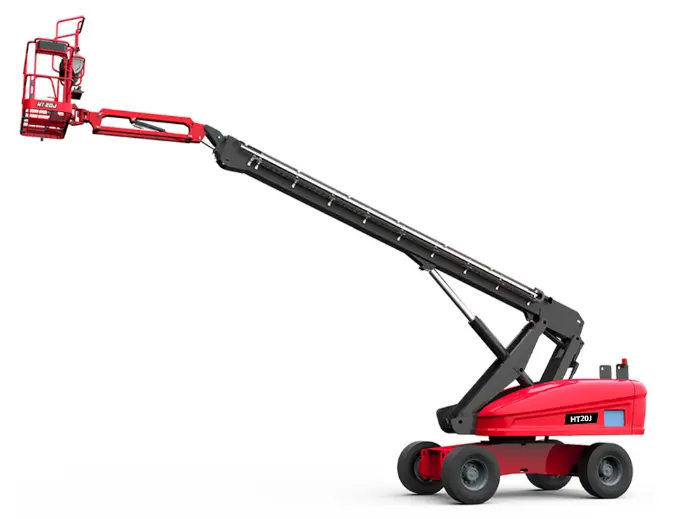What Are Boom Lifts Typically Used to Support?
A boom lift, also referred to as a cherry picker or man lift, is an aerial work platform designed to offer temporary access to inaccessible areas, typically at elevated heights. It functions using a hydraulic arm that extends outward and upward, featuring a platform or bucket at the end for the operator. Boom lifts find widespread application in construction, warehouse management, maintenance, and various other industries that involve tasks requiring high-reaching capabilities.
Three Key Points about Boom Lifts:
1. Safety: Boom lifts pose significant safety risks. Proper operator training is essential due to their large size, weight, and potential for causing serious injuries if mishandled.
2. Versatility: One of the standout benefits of boom lifts is their versatility. Widely utilized in construction, maintenance, film production, and numerous other industries, their extendable arm and bucket enable access to difficult-to-reach areas, making them indispensable for various tasks.
3. Maintenance: Regular and proper maintenance is crucial for extending the lifespan of a boom lift. Scheduled inspections by certified professionals are vital to ensure optimal performance and prevent accidents.
The Importance of Boom Lifts
A boom lift, also recognized as a cherry picker or man lift, holds immense significance in the realms of construction and maintenance, owing to its operational capabilities and safety features. It serves as a pivotal tool for safely elevating workers to inaccessible areas, mitigating the risks associated with ladders or scaffolding. With its ability to navigate and reach heights adeptly and precisely, a boom lift enhances efficiency, preventing delays in tasks such as painting, cleaning, repairs, or fixture installations.
The lifting and reaching capabilities of a boom lift are indispensable, enabling the completion of otherwise impossible tasks or those requiring significantly more time and effort. Consequently, boom lifts play a vital role across various industries, contributing to project success and ensuring safety.
How Boom Lifts are Used
Boom lifts, integral to construction and maintenance operations, are indispensable for tasks necessitating elevated access. It is designed to help workers safely reach elevated and hard-to-reach areas, thus enhancing efficiency and productivity.
A boom lift is typically used for construction, window cleaning, painting, installation, tree trimming, and many other tasks involving high areas. Beyond simply facilitating high-reaching tasks, boom lifts play a crucial role in enhancing safety and accelerating job completion. They provide a stable platform, reducing the risk of falls and enabling efficient work execution.
One notable benefit is their versatility and maneuverability, allowing movement in multiple directions: upward, downward, and sideways. Larger variants of these machines can extend to remarkable heights, with select models reaching up to 185 feet. It's imperative to emphasize that operating this equipment demands proper training to safeguard both operators and individuals in the vicinity.
Examples of Boom Lift Applications
1. Building Maintenance and Repairs:
Maintenance crews frequently utilize boom lifts for repairing or cleaning tall residential or commercial building exteriors. For instance, if high-rise building window panes require replacement or outdoor light fixtures need fixing, a boom lift is deployed to elevate the crew to the necessary height.
2. Construction Industry:
In new high-rise construction projects, boom lifts are essential for transporting materials and workers to elevated scaffolding levels. They assist in lifting heavy materials to upper floors, aiding in window or ventilation system installations, and providing a secure platform for construction workers operating at heights.
3. Tree Care Services:
Tree surgeons rely on boom lifts for trimming tall trees. Utilizing a boom lift, a tree surgeon can safely reach the desired height and efficiently carry out their work. This process ensures the tree's health and enhances safety for people and property beneath it.
Differences between Boom Lift and Scissor Lift
Feature | Boom Lift | |
Movement | Articulating or Telescopic | Vertical only |
Reach | High reach, often up to 185 feet | Lower reach, typically up to 40-50 feet |
Direction | Can extend in all directions (up, down, sideways) | Can only move vertically |
Platform Size | Relatively larger platform | Smaller platform |
Stability | Requires outriggers for stability | Self-leveling, stable on flat surfaces |
Use Cases | Construction, maintenance, window cleaning, tree trimming | Indoor maintenance, installation, and tasks in confined spaces |
Maneuverability | Less maneuverable due to outriggers and larger size | Highly maneuverable in tight spaces |
Typical Applications | Outdoor tasks with the need for high reach and flexibility | Indoor maintenance, warehouse stocking, and low to mid-height tasks |
Transportation | May require special transport due to size | Can be easily moved with standard trailers or trucks |
Cost | Generally more expensive | Generally more affordable |
Frequently Asked Questions (FAQs)
Q: What is a boom lift?
A: A boom lift, also known as a cherry picker or man lift, is an aerial work platform designed to allow workers to access high or inaccessible areas. It features a platform or bucket attached to a hydraulic lifting system connected to a grounded base.
Q: How high can a boom lift reach?
A: The reach of a boom lift varies depending on the specific model, but typically ranges from 30 feet to 180 feet in height.
Q: What is the difference between a boom lift and a scissor lift?
A: A scissor lift can only move vertically and is restricted to working directly overhead, while a boom lift can extend in various directions, providing greater flexibility and reach.
Q: Who can operate a boom lift?
A: Only trained and certified professionals are permitted to operate a boom lift due to safety considerations. Operator certification typically involves both classroom instruction and hands-on training.
Q: What safety precautions should be observed when using a boom lift?
A: Operators should wear a harness at all times, ensure the lift is positioned on stable ground before ascending, maintain a clear work area free of people and obstacles, and avoid exceeding the weight limit.
Q: Can boom lifts be used indoors?
A: Yes, boom lifts can be used indoors if there is adequate space. However, certain models may require ventilation due to emissions.
Q: What types of tasks are boom lifts used for?
A: Boom lifts are commonly employed in construction, maintenance, warehouse stocking, painting, tree work, and any tasks that require access to high or inaccessible areas.
Q: Which type of boom lift should I use for my project?
A: The appropriate boom lift for your project depends on specific requirements such as height, reach, indoor/outdoor setting, and weight limit.
Q: Is the boom lift electric or diesel-powered?
A: Boom lifts are available in both electric and diesel models. Electric models are quieter and more environmentally friendly, typically used indoors, while diesel models are utilized for outdoor construction projects requiring additional power.






